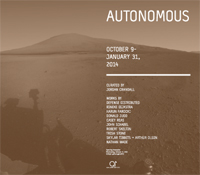AUTONOMOUS Exhibition Opening and Reception |
||
|
||
|
DESCRIPTION/ABSTRACT: Exhibition Dates: October 9-January 30, 2014 (N.B. The gallery will be closed for holidays from Dec. 21, 2013 through Jan. 5, 2014.) Gallery Hours: 11am-5pm, Monday-Friday The exhibition AUTONOMOUS is the brainchild of Jordan Crandall, professor and chair in the Department of Visual Arts at UC San Diego. The exhibition runs from Oct. 9 through January 30. Crandall pulled together works by a dozen artists and researchers, and their works represent a dizzying array of concepts that approach the concept of autonomy from very different angles. Some of the installations are interactive, some not. Some of the works are by dyed-in-the-wool artists, while others originated in the minds of scientists and technologists. Skylar Tibbits of MIT and Arthur Olson of The Scripps Research Institute in La Jolla produced Autonomous Mass-Assembly. The work is the latest in a series of pieces based on the notions of self-selection and self-assembly. The 2013 installation uses an agitation machine to energize roughly 240 pieces modeled on the polio virus capsid. Each autonomous piece appears to assume a life of its own as it self-assembles with other pieces into closed, molecular-type structures. Another 2013 piece, Liberator, is an object fabricated using 3D printing – the rapid prototyping of a solid object by building it up from melted polymer, one layer at a time. The design originated with Defense Distributed, which last May made headlines worldwide when it released the files for printing the Liberator pistol, the first, fully 3D-printable gun made widely available online. The files were downloaded over 100,000 times in the two days before the U.S. Department of State Office of Defense Trade Controls Compliance demanded that they be taken down. A Liberator will be on display. The autonomous nature of modern weapons technology is also on display in a video piece by German artist and film director Harun Farocki: Auge/Maschine II (Eye/Machine II in English). The 15-minute video integrates military and civilian material – some real, some imagined using special effects – underscoring how computer vision has overtaken human sight, especially as a witness to history, turning the traditional man-machine distinction into an eye-machine divide. The exhibition includes a series of works from the 1970s that offer new insights into the production process of artist Donald Judd. Other works on display in the gallery@calit2 include: • Rami: Givati Brigade, Rotem Regiment, Golan Heights, Israel (2000), by Rineke Dijkstra; • Network B (2009), generative software by Casey Reas; • Untitled (Passenger #3), from a series of photographs of airline passengers, by John Schabel; and • Untitled, What Followed Was Amazing Bliss (2013), a video project with custom software by Nathan Wade. Two UC San Diego works will also be exhibited. The first is View from Curiosity, August 2012, for which Trish Stone, an artist who performs visualization research in the Qualcomm Institute, manipulated an image from NASA/Jet Propulsion Laboratory at Caltech to produce large ink-jet prints. The second work is Mass-Efficient Deployable Tensegrity Structure. Made of balsa wood and tensioned string, it was built by Robert Skelton, a professor of mechanical and aerospace engineering in the UCSD Jacobs School of Engineering. Tensegrity is a growing paradigm for designers of new materials and structures. Composed of continuous strings and sticks, structures built with tensegrity are malleable, flexible and adaptable. How they are put together can change the acoustic, mechanical or electromagnetic properties of a material. |

